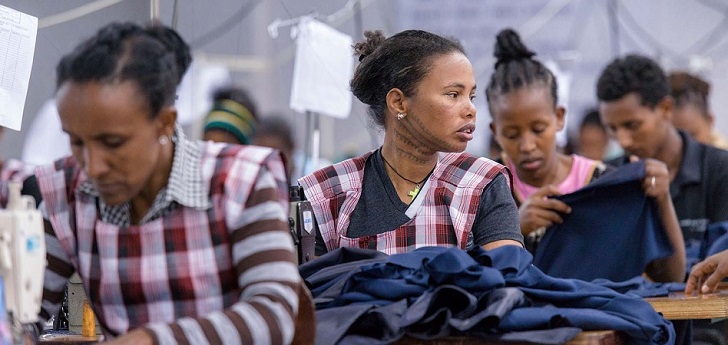Ethiopia, the next front of sourcing in the light of the coronavirus crisis
Inditex, H&M, Decathlon or Primark are some of the major operators in the sector that have already opted to source from the African country. Chinese know how and low labour costs are its main incentives for the sector.

The prospect for fashion expands beyond Cambodia, Myanmar, Vietnam or Bangladesh. The coronavirus crisis has triggered the turn of large operators in the sector to supply outside of China. With Southeast Asia and Turkey on the brink of saturation, Ethiopia is now positioned as one of the most striking hubs for the sector, where the focus has been on for several years. Low salaries, foreign investment led by China and commitment to infrastructure are the country’s biggest incentives for operators in the sector.
Although the first textile factories in Ethiopia were launched in 1939, it wasn’t until until recent years that the sector flipped, growing at an annual average of more than 50% and hosting around 65 international investment projects.
The factories present in the territory today produce wool, cotton and nylon fabrics, acrylic and cotton threads, sewing thread and ready-made garments, among others. The economic plans of the country go through being the main textile supply hub in Africa in eight years, following in the footsteps of other countries such as Vietnam or Bangladesh.
H&M bet on Ethiopia in 2014 with the launch of a joint venture with a local partner
Inditex, H&M, Decathlon or Primark are some of the major operators in the sector that have already opted to stock up in the African country. The Swedish company was the first major company that opted for Ethiopia as a textile hub, starting operations in the country in 2014.
The Swedish fashion distribution group chose to set up joint ventures with local manufacturers to train workers and prepare factory executives. “The textile industry in Ethiopia can develop faster than in other countries due to its technological advancement and learning,” Arwin Ludiansyah, responsible for the production of H&M in the country, once explained.
Currently, the Swedish retailer has 31 suppliers in Ethiopia. Among them are companies such as A’is Ventures Private Limited, KPR Mill, KPR Exports, DBL Industries, Indochine Apparel, Kebire Enterprises, Atraco Industrial Enterprises, Ashton Apparel Manufacturing, Vestis Garment Production or Fuanlai Textile Ethiopia.
The American PVH, meanwhile, began to stock up in Ethiopia in 2017 also through a joint venture with a local partner. The company’s products made in the country are mainly from the Heritage Brands segment.
The Ethiopian Government expects the country’s textile exports to reach $300 billion
Backed by the giant’s commitment, by 2025, the Ethiopian government expects the country’s textile exports to reach 300 billion dollars. The future outlooks of the administration are optimistic considering that, in 2016, foreign sales in the sector reached 115 million dollars, 56% more than the previous year. In 2019, the country exported fashion goods to Europe worth 67.7 million euros, 49% more than a year ago.
Another attraction of the country derives from China’s commitment to Ethiopian textile. As a result of the commercial war with the United States, Chinese entrepreneurs have begun to invest in the African country for a few months to export products from Ethiopia with Chinese know-how.
In September 2018, several representatives of the Chinese Chamber of Commerce for Textiles met with the leaders of the Ethiopian Textile and Confection Manufacturers Association with the aim of exploring possibilities in Chinese investment in the country. “I witnessed the great progress made in the development of the industry,” said Zhang Xi’an, vice president of the Chinese body.
In recent years, China has increased its investments in the country
With the rise of the textile industry, the sector’s syndicates have taken the opportunity to negotiate the conditions of the workers. Last November, the organizations agreed to work together to establish a common collective bargaining strategy. The meeting was attended by about thirty union leaders of the Industrial Federation of the Leather Workers and Textile Confederation, affiliated with IndustriAll and agreed to work together and thus move away from individual negotiations with companies.
At the meeting, participants also agreed on the need for a national negotiation conference to consolidate their demands about living wages and the improvement in the health and safety of the country’s factories. Currently, textile and garment employees in the country charge about twenty-six dollars a month, compared to 146 dollars in China or 95 dollars in Bangladesh.
Textile workers in Ethiopia charge twenty-six euros a month
In addition, the country has also joined forces with new initiatives to become one of the main supply poles in the world. In 2019, the SGS certification company launched a textile-testing laboratory.
Located in the Hawassa Industrial Park, in the city of the same name, it aims to strengthen the capacity of the country’s textile sector and ensure compliance with global standards for production.
In the last year, other projects have also been launched to prop up the country’s infrastructure, such as the construction of the Jimma Industrial Park and the Dire Dawa Industrial Park, which mainly houses textile and clothing factories on 14.5 hectares.
One of the largest operations to strengthen the Ethiopian textile industry was the opening in 2010 of Ayka Addis, a subsidiary of the Turkish Ayka Textile, which involved an investment of 120 million euros. The Bengali group DBL, meanwhile, has invested one hundred million dollars in a textile and clothing factory, which was launched in February 2018 with a workforce of 150,000 workers.


info@themds.com
Validation policy for comments:
MDS does not perform prior verification for the publication of comments. However, to prevent anonymous comments from affecting the rights of third parties without the ability to reply, all comments require a valid email address, which won’t be visible or shared.
Enter your name and email address to be able to comment on this news: once you click on the link you will find within your verification email, your comment will be published.